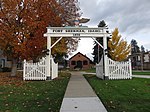Coeur d'Alene ( KOR də-LAYN; French: Cœur d'Alène, lit. 'Heart of an Awl' French pronunciation: [kœʁ d‿a.lɛn]) is a city and the county seat of Kootenai County, Idaho, United States. It is the largest city in North Idaho and the principal city of the Coeur d'Alene Metropolitan Statistical Area. The population was 54,628 at the 2020 census. Coeur d'Alene is a satellite city of Spokane, which is located about thirty miles (50 km) to the west in the state of Washington. The two cities are the key components of the Spokane–Coeur d'Alene Combined Statistical Area, of which Coeur d'Alene is the third-largest city (after Spokane and its largest suburb, Spokane Valley). The city is situated on the north shore of the 25-mile (40 km) long Lake Coeur d'Alene and to the west of the Coeur d'Alene Mountains. Locally, Coeur d'Alene is known as the "Lake City," or simply called by its initials, "CDA."
The city is named after the Coeur d'Alene people, a federally recognized tribe of Native Americans who live along the rivers and lakes of the region, in a territory of 4,000,000 acres (16,000 km2) from eastern Washington to Montana. The native peoples were hunter-gatherers who located their villages and camps near food gathering or processing sites and followed the seasonal cycles, practicing subsistence hunting, fishing, and foraging.
The city began as a fort town; General William Tecumseh Sherman sited what became known as Fort Sherman on the north shore of Lake Coeur d'Alene in 1878. Peopling of the town came when miners and prospectors came to the region after gold and silver deposits were found in what would become the Silver Valley and after the Northern Pacific Railroad reached the town in 1883. In the 1890s, two significant miners' uprisings over wages took place in the Coeur d'Alene Mining District leading to the declaration of martial law, with the latter providing a motive for the assassination of a former Idaho governor and subsequently a nationally publicized trial. The late 19th century discovery of highly prized white pine in the forests of northern Idaho resulted in a timber boom that peaked in the late 1920s and was accompanied by the rapid population growth which led to the incorporation of the city on September 4, 1906. After the Great Depression, tourism started to become a major source of development in the area. By the 1980s, tourism became the major driver in the local economy, and, after decades of heavy reliance on logging, the city featured a more balanced economy with manufacturing, retail, and service sectors.
The city of Coeur d'Alene has grown significantly since the 1990s, in part because of a substantial increase in tourism, encouraged by resorts and recreational activities in the area and outmigration predominantly from other western states. The Coeur d'Alene Resort and its 0.75-mile (1.21 km) floating boardwalk and a 165-acre (0.67 km2) natural area called Tubbs Hill take up a prominent portion of the city's downtown. Popular parks such as City Park and Beach and McEuen Park are also fixtures of the downtown waterfront. The city has become somewhat of a destination for golfers; there are five courses in the city, including the Coeur d'Alene Resort Golf Course and its unique 14th hole floating green. The Coeur d'Alene Casino and its Circling Raven Golf Club is located approximately 27 miles (43 km) south and the largest theme park in the Northwestern United States, Silverwood Theme Park, is located approximately twenty miles (30 km) north. There are also several ski resorts and other recreation areas nearby. The city is home to the Museum of North Idaho and North Idaho College, and it has become known for having one of the largest holiday light shows in the United States and hosting a popular Ironman Triathlon event. Coeur d'Alene is located on the route of Interstate 90 and is served by the Coeur d'Alene Airport as well as the Brooks Seaplane Base by air. In print media, local issues are covered by the Coeur d'Alene Press daily newspaper.






